Assignment On Law Of Business Organisation
VerifiedAdded on 2022/10/06
|7
|2099
|21
Assignment
AI Summary
Contribute Materials
Your contribution can guide someone’s learning journey. Share your
documents today.
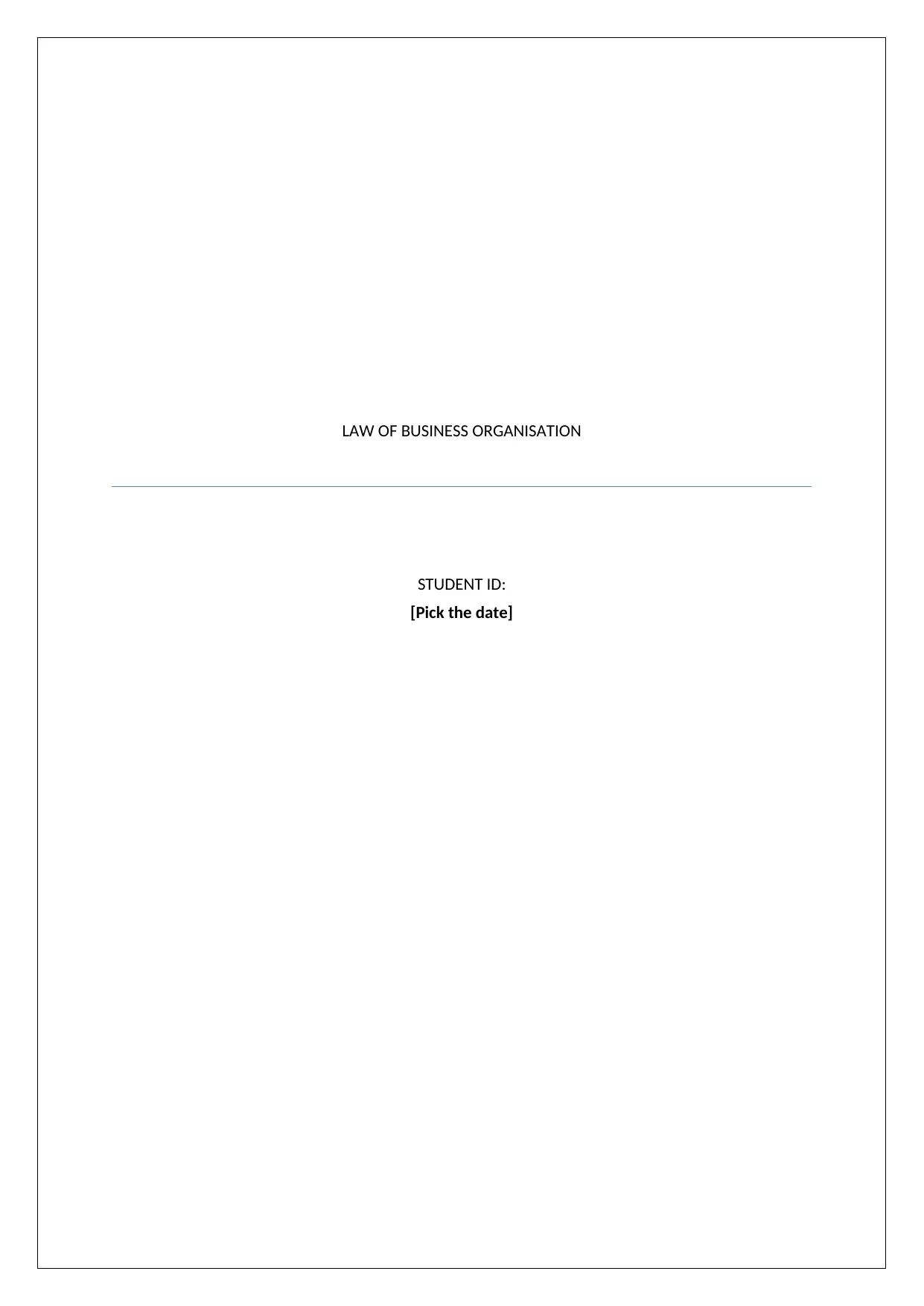
LAW OF BUSINESS ORGANISATION
STUDENT ID:
[Pick the date]
STUDENT ID:
[Pick the date]
Secure Best Marks with AI Grader
Need help grading? Try our AI Grader for instant feedback on your assignments.
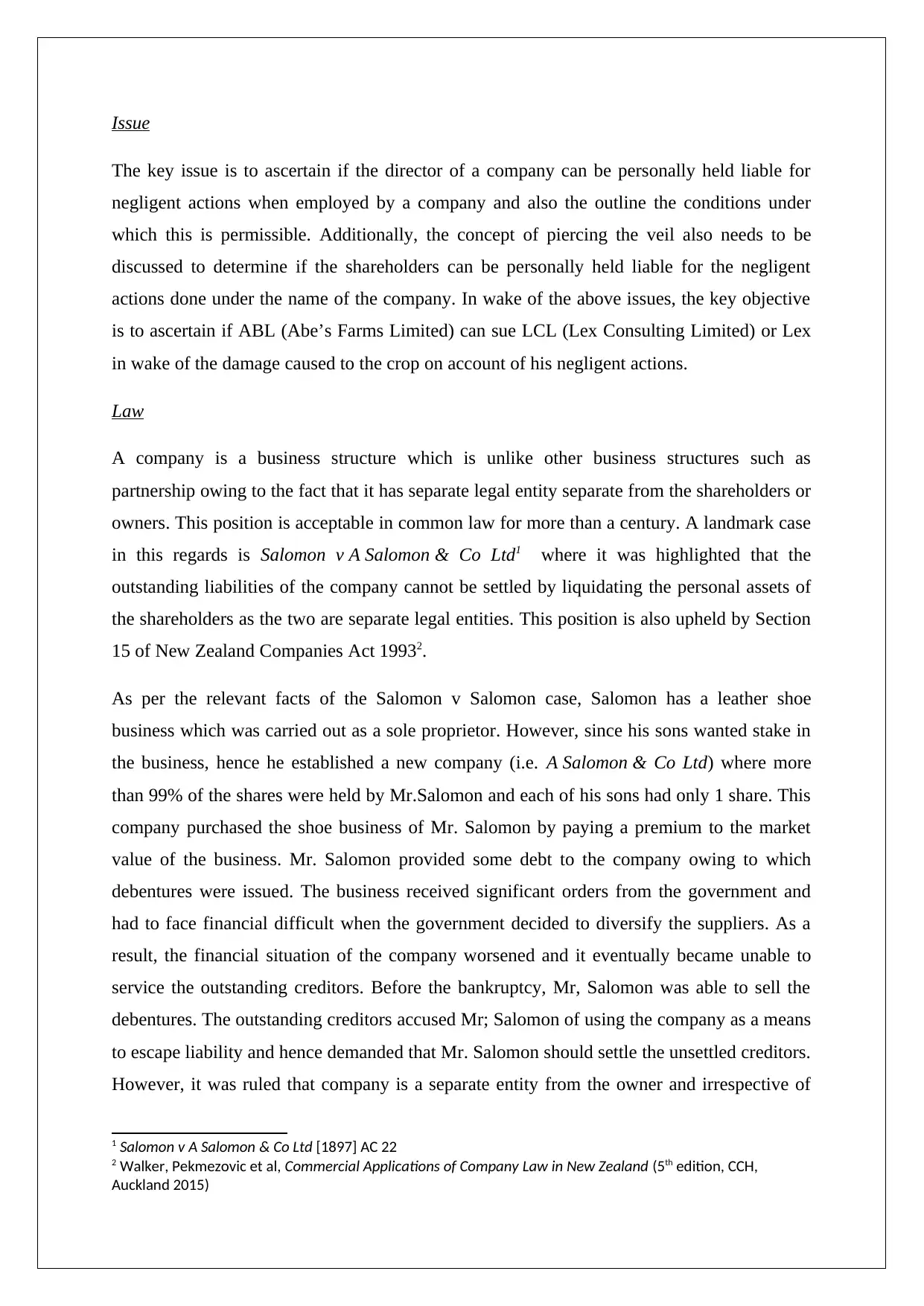
Issue
The key issue is to ascertain if the director of a company can be personally held liable for
negligent actions when employed by a company and also the outline the conditions under
which this is permissible. Additionally, the concept of piercing the veil also needs to be
discussed to determine if the shareholders can be personally held liable for the negligent
actions done under the name of the company. In wake of the above issues, the key objective
is to ascertain if ABL (Abe’s Farms Limited) can sue LCL (Lex Consulting Limited) or Lex
in wake of the damage caused to the crop on account of his negligent actions.
Law
A company is a business structure which is unlike other business structures such as
partnership owing to the fact that it has separate legal entity separate from the shareholders or
owners. This position is acceptable in common law for more than a century. A landmark case
in this regards is Salomon v A Salomon & Co Ltd1 where it was highlighted that the
outstanding liabilities of the company cannot be settled by liquidating the personal assets of
the shareholders as the two are separate legal entities. This position is also upheld by Section
15 of New Zealand Companies Act 19932.
As per the relevant facts of the Salomon v Salomon case, Salomon has a leather shoe
business which was carried out as a sole proprietor. However, since his sons wanted stake in
the business, hence he established a new company (i.e. A Salomon & Co Ltd) where more
than 99% of the shares were held by Mr.Salomon and each of his sons had only 1 share. This
company purchased the shoe business of Mr. Salomon by paying a premium to the market
value of the business. Mr. Salomon provided some debt to the company owing to which
debentures were issued. The business received significant orders from the government and
had to face financial difficult when the government decided to diversify the suppliers. As a
result, the financial situation of the company worsened and it eventually became unable to
service the outstanding creditors. Before the bankruptcy, Mr, Salomon was able to sell the
debentures. The outstanding creditors accused Mr; Salomon of using the company as a means
to escape liability and hence demanded that Mr. Salomon should settle the unsettled creditors.
However, it was ruled that company is a separate entity from the owner and irrespective of
1 Salomon v A Salomon & Co Ltd [1897] AC 22
2 Walker, Pekmezovic et al, Commercial Applications of Company Law in New Zealand (5th edition, CCH,
Auckland 2015)
The key issue is to ascertain if the director of a company can be personally held liable for
negligent actions when employed by a company and also the outline the conditions under
which this is permissible. Additionally, the concept of piercing the veil also needs to be
discussed to determine if the shareholders can be personally held liable for the negligent
actions done under the name of the company. In wake of the above issues, the key objective
is to ascertain if ABL (Abe’s Farms Limited) can sue LCL (Lex Consulting Limited) or Lex
in wake of the damage caused to the crop on account of his negligent actions.
Law
A company is a business structure which is unlike other business structures such as
partnership owing to the fact that it has separate legal entity separate from the shareholders or
owners. This position is acceptable in common law for more than a century. A landmark case
in this regards is Salomon v A Salomon & Co Ltd1 where it was highlighted that the
outstanding liabilities of the company cannot be settled by liquidating the personal assets of
the shareholders as the two are separate legal entities. This position is also upheld by Section
15 of New Zealand Companies Act 19932.
As per the relevant facts of the Salomon v Salomon case, Salomon has a leather shoe
business which was carried out as a sole proprietor. However, since his sons wanted stake in
the business, hence he established a new company (i.e. A Salomon & Co Ltd) where more
than 99% of the shares were held by Mr.Salomon and each of his sons had only 1 share. This
company purchased the shoe business of Mr. Salomon by paying a premium to the market
value of the business. Mr. Salomon provided some debt to the company owing to which
debentures were issued. The business received significant orders from the government and
had to face financial difficult when the government decided to diversify the suppliers. As a
result, the financial situation of the company worsened and it eventually became unable to
service the outstanding creditors. Before the bankruptcy, Mr, Salomon was able to sell the
debentures. The outstanding creditors accused Mr; Salomon of using the company as a means
to escape liability and hence demanded that Mr. Salomon should settle the unsettled creditors.
However, it was ruled that company is a separate entity from the owner and irrespective of
1 Salomon v A Salomon & Co Ltd [1897] AC 22
2 Walker, Pekmezovic et al, Commercial Applications of Company Law in New Zealand (5th edition, CCH,
Auckland 2015)
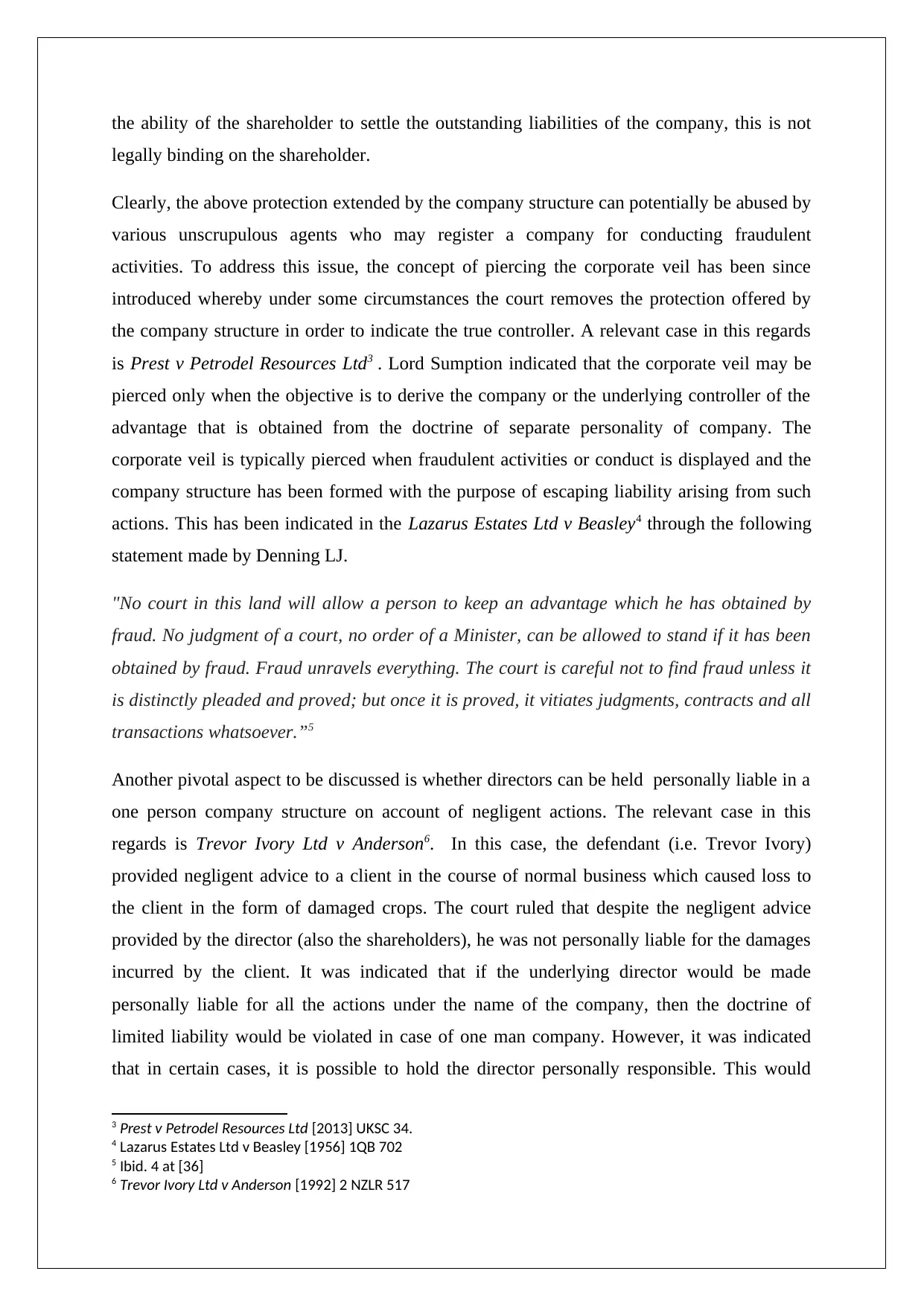
the ability of the shareholder to settle the outstanding liabilities of the company, this is not
legally binding on the shareholder.
Clearly, the above protection extended by the company structure can potentially be abused by
various unscrupulous agents who may register a company for conducting fraudulent
activities. To address this issue, the concept of piercing the corporate veil has been since
introduced whereby under some circumstances the court removes the protection offered by
the company structure in order to indicate the true controller. A relevant case in this regards
is Prest v Petrodel Resources Ltd3 . Lord Sumption indicated that the corporate veil may be
pierced only when the objective is to derive the company or the underlying controller of the
advantage that is obtained from the doctrine of separate personality of company. The
corporate veil is typically pierced when fraudulent activities or conduct is displayed and the
company structure has been formed with the purpose of escaping liability arising from such
actions. This has been indicated in the Lazarus Estates Ltd v Beasley4 through the following
statement made by Denning LJ.
"No court in this land will allow a person to keep an advantage which he has obtained by
fraud. No judgment of a court, no order of a Minister, can be allowed to stand if it has been
obtained by fraud. Fraud unravels everything. The court is careful not to find fraud unless it
is distinctly pleaded and proved; but once it is proved, it vitiates judgments, contracts and all
transactions whatsoever.”5
Another pivotal aspect to be discussed is whether directors can be held personally liable in a
one person company structure on account of negligent actions. The relevant case in this
regards is Trevor Ivory Ltd v Anderson6. In this case, the defendant (i.e. Trevor Ivory)
provided negligent advice to a client in the course of normal business which caused loss to
the client in the form of damaged crops. The court ruled that despite the negligent advice
provided by the director (also the shareholders), he was not personally liable for the damages
incurred by the client. It was indicated that if the underlying director would be made
personally liable for all the actions under the name of the company, then the doctrine of
limited liability would be violated in case of one man company. However, it was indicated
that in certain cases, it is possible to hold the director personally responsible. This would
3 Prest v Petrodel Resources Ltd [2013] UKSC 34.
4 Lazarus Estates Ltd v Beasley [1956] 1QB 702
5 Ibid. 4 at [36]
6 Trevor Ivory Ltd v Anderson [1992] 2 NZLR 517
legally binding on the shareholder.
Clearly, the above protection extended by the company structure can potentially be abused by
various unscrupulous agents who may register a company for conducting fraudulent
activities. To address this issue, the concept of piercing the corporate veil has been since
introduced whereby under some circumstances the court removes the protection offered by
the company structure in order to indicate the true controller. A relevant case in this regards
is Prest v Petrodel Resources Ltd3 . Lord Sumption indicated that the corporate veil may be
pierced only when the objective is to derive the company or the underlying controller of the
advantage that is obtained from the doctrine of separate personality of company. The
corporate veil is typically pierced when fraudulent activities or conduct is displayed and the
company structure has been formed with the purpose of escaping liability arising from such
actions. This has been indicated in the Lazarus Estates Ltd v Beasley4 through the following
statement made by Denning LJ.
"No court in this land will allow a person to keep an advantage which he has obtained by
fraud. No judgment of a court, no order of a Minister, can be allowed to stand if it has been
obtained by fraud. Fraud unravels everything. The court is careful not to find fraud unless it
is distinctly pleaded and proved; but once it is proved, it vitiates judgments, contracts and all
transactions whatsoever.”5
Another pivotal aspect to be discussed is whether directors can be held personally liable in a
one person company structure on account of negligent actions. The relevant case in this
regards is Trevor Ivory Ltd v Anderson6. In this case, the defendant (i.e. Trevor Ivory)
provided negligent advice to a client in the course of normal business which caused loss to
the client in the form of damaged crops. The court ruled that despite the negligent advice
provided by the director (also the shareholders), he was not personally liable for the damages
incurred by the client. It was indicated that if the underlying director would be made
personally liable for all the actions under the name of the company, then the doctrine of
limited liability would be violated in case of one man company. However, it was indicated
that in certain cases, it is possible to hold the director personally responsible. This would
3 Prest v Petrodel Resources Ltd [2013] UKSC 34.
4 Lazarus Estates Ltd v Beasley [1956] 1QB 702
5 Ibid. 4 at [36]
6 Trevor Ivory Ltd v Anderson [1992] 2 NZLR 517
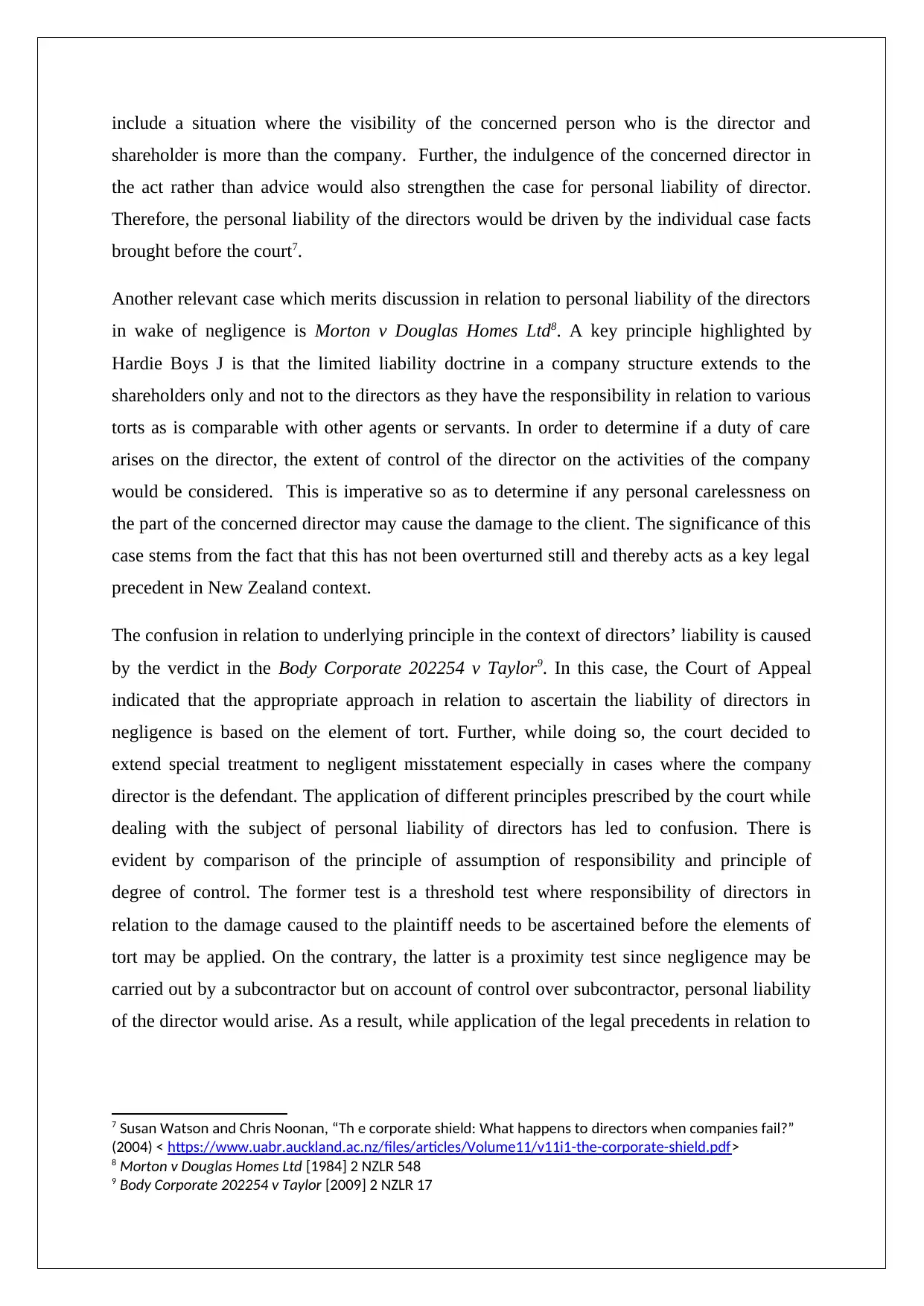
include a situation where the visibility of the concerned person who is the director and
shareholder is more than the company. Further, the indulgence of the concerned director in
the act rather than advice would also strengthen the case for personal liability of director.
Therefore, the personal liability of the directors would be driven by the individual case facts
brought before the court7.
Another relevant case which merits discussion in relation to personal liability of the directors
in wake of negligence is Morton v Douglas Homes Ltd8. A key principle highlighted by
Hardie Boys J is that the limited liability doctrine in a company structure extends to the
shareholders only and not to the directors as they have the responsibility in relation to various
torts as is comparable with other agents or servants. In order to determine if a duty of care
arises on the director, the extent of control of the director on the activities of the company
would be considered. This is imperative so as to determine if any personal carelessness on
the part of the concerned director may cause the damage to the client. The significance of this
case stems from the fact that this has not been overturned still and thereby acts as a key legal
precedent in New Zealand context.
The confusion in relation to underlying principle in the context of directors’ liability is caused
by the verdict in the Body Corporate 202254 v Taylor9. In this case, the Court of Appeal
indicated that the appropriate approach in relation to ascertain the liability of directors in
negligence is based on the element of tort. Further, while doing so, the court decided to
extend special treatment to negligent misstatement especially in cases where the company
director is the defendant. The application of different principles prescribed by the court while
dealing with the subject of personal liability of directors has led to confusion. There is
evident by comparison of the principle of assumption of responsibility and principle of
degree of control. The former test is a threshold test where responsibility of directors in
relation to the damage caused to the plaintiff needs to be ascertained before the elements of
tort may be applied. On the contrary, the latter is a proximity test since negligence may be
carried out by a subcontractor but on account of control over subcontractor, personal liability
of the director would arise. As a result, while application of the legal precedents in relation to
7 Susan Watson and Chris Noonan, “Th e corporate shield: What happens to directors when companies fail?”
(2004) < https://www.uabr.auckland.ac.nz/files/articles/Volume11/v11i1-the-corporate-shield.pdf>
8 Morton v Douglas Homes Ltd [1984] 2 NZLR 548
9 Body Corporate 202254 v Taylor [2009] 2 NZLR 17
shareholder is more than the company. Further, the indulgence of the concerned director in
the act rather than advice would also strengthen the case for personal liability of director.
Therefore, the personal liability of the directors would be driven by the individual case facts
brought before the court7.
Another relevant case which merits discussion in relation to personal liability of the directors
in wake of negligence is Morton v Douglas Homes Ltd8. A key principle highlighted by
Hardie Boys J is that the limited liability doctrine in a company structure extends to the
shareholders only and not to the directors as they have the responsibility in relation to various
torts as is comparable with other agents or servants. In order to determine if a duty of care
arises on the director, the extent of control of the director on the activities of the company
would be considered. This is imperative so as to determine if any personal carelessness on
the part of the concerned director may cause the damage to the client. The significance of this
case stems from the fact that this has not been overturned still and thereby acts as a key legal
precedent in New Zealand context.
The confusion in relation to underlying principle in the context of directors’ liability is caused
by the verdict in the Body Corporate 202254 v Taylor9. In this case, the Court of Appeal
indicated that the appropriate approach in relation to ascertain the liability of directors in
negligence is based on the element of tort. Further, while doing so, the court decided to
extend special treatment to negligent misstatement especially in cases where the company
director is the defendant. The application of different principles prescribed by the court while
dealing with the subject of personal liability of directors has led to confusion. There is
evident by comparison of the principle of assumption of responsibility and principle of
degree of control. The former test is a threshold test where responsibility of directors in
relation to the damage caused to the plaintiff needs to be ascertained before the elements of
tort may be applied. On the contrary, the latter is a proximity test since negligence may be
carried out by a subcontractor but on account of control over subcontractor, personal liability
of the director would arise. As a result, while application of the legal precedents in relation to
7 Susan Watson and Chris Noonan, “Th e corporate shield: What happens to directors when companies fail?”
(2004) < https://www.uabr.auckland.ac.nz/files/articles/Volume11/v11i1-the-corporate-shield.pdf>
8 Morton v Douglas Homes Ltd [1984] 2 NZLR 548
9 Body Corporate 202254 v Taylor [2009] 2 NZLR 17
Secure Best Marks with AI Grader
Need help grading? Try our AI Grader for instant feedback on your assignments.
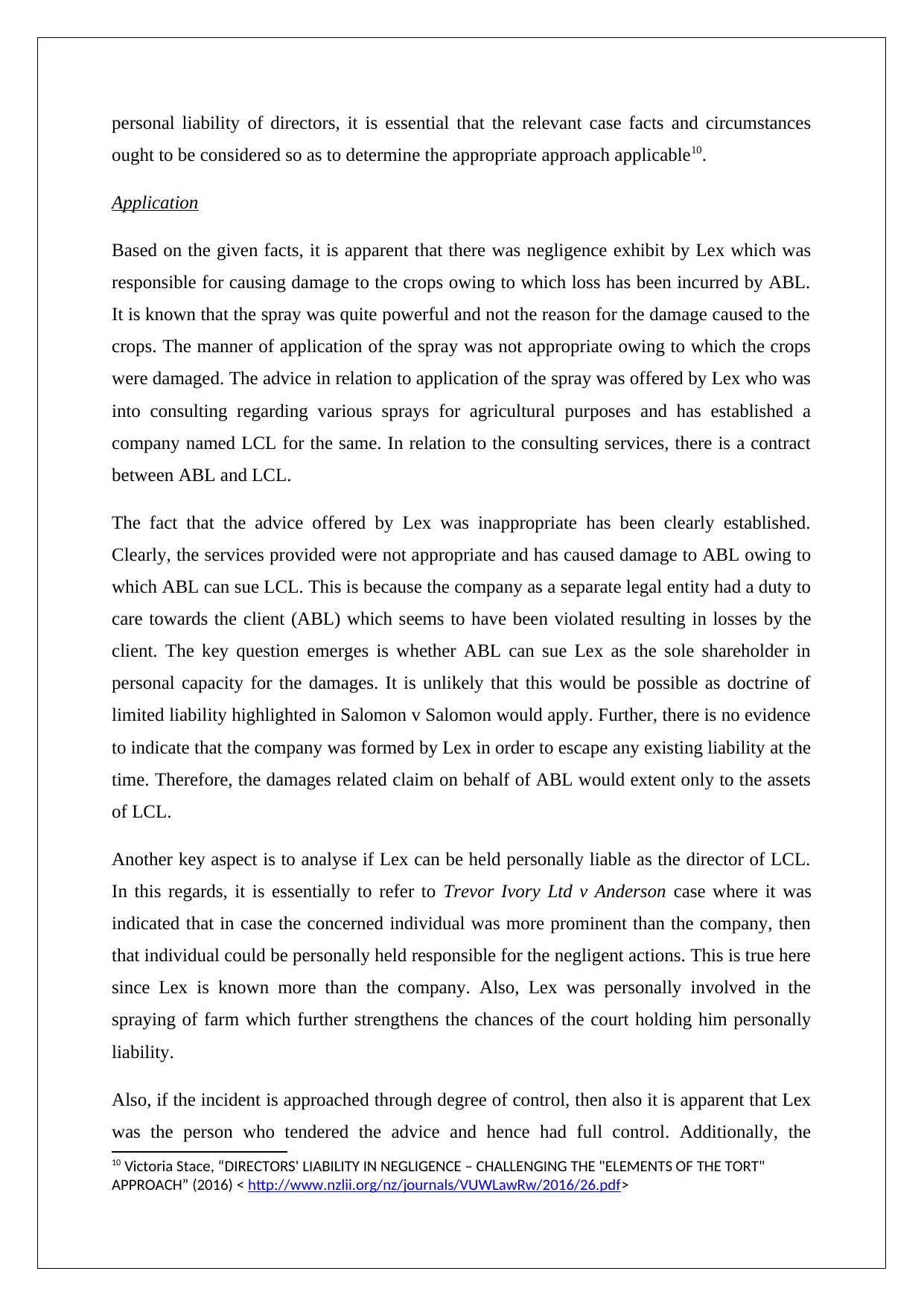
personal liability of directors, it is essential that the relevant case facts and circumstances
ought to be considered so as to determine the appropriate approach applicable10.
Application
Based on the given facts, it is apparent that there was negligence exhibit by Lex which was
responsible for causing damage to the crops owing to which loss has been incurred by ABL.
It is known that the spray was quite powerful and not the reason for the damage caused to the
crops. The manner of application of the spray was not appropriate owing to which the crops
were damaged. The advice in relation to application of the spray was offered by Lex who was
into consulting regarding various sprays for agricultural purposes and has established a
company named LCL for the same. In relation to the consulting services, there is a contract
between ABL and LCL.
The fact that the advice offered by Lex was inappropriate has been clearly established.
Clearly, the services provided were not appropriate and has caused damage to ABL owing to
which ABL can sue LCL. This is because the company as a separate legal entity had a duty to
care towards the client (ABL) which seems to have been violated resulting in losses by the
client. The key question emerges is whether ABL can sue Lex as the sole shareholder in
personal capacity for the damages. It is unlikely that this would be possible as doctrine of
limited liability highlighted in Salomon v Salomon would apply. Further, there is no evidence
to indicate that the company was formed by Lex in order to escape any existing liability at the
time. Therefore, the damages related claim on behalf of ABL would extent only to the assets
of LCL.
Another key aspect is to analyse if Lex can be held personally liable as the director of LCL.
In this regards, it is essentially to refer to Trevor Ivory Ltd v Anderson case where it was
indicated that in case the concerned individual was more prominent than the company, then
that individual could be personally held responsible for the negligent actions. This is true here
since Lex is known more than the company. Also, Lex was personally involved in the
spraying of farm which further strengthens the chances of the court holding him personally
liability.
Also, if the incident is approached through degree of control, then also it is apparent that Lex
was the person who tendered the advice and hence had full control. Additionally, the
10 Victoria Stace, “DIRECTORS' LIABILITY IN NEGLIGENCE – CHALLENGING THE "ELEMENTS OF THE TORT"
APPROACH” (2016) < http://www.nzlii.org/nz/journals/VUWLawRw/2016/26.pdf>
ought to be considered so as to determine the appropriate approach applicable10.
Application
Based on the given facts, it is apparent that there was negligence exhibit by Lex which was
responsible for causing damage to the crops owing to which loss has been incurred by ABL.
It is known that the spray was quite powerful and not the reason for the damage caused to the
crops. The manner of application of the spray was not appropriate owing to which the crops
were damaged. The advice in relation to application of the spray was offered by Lex who was
into consulting regarding various sprays for agricultural purposes and has established a
company named LCL for the same. In relation to the consulting services, there is a contract
between ABL and LCL.
The fact that the advice offered by Lex was inappropriate has been clearly established.
Clearly, the services provided were not appropriate and has caused damage to ABL owing to
which ABL can sue LCL. This is because the company as a separate legal entity had a duty to
care towards the client (ABL) which seems to have been violated resulting in losses by the
client. The key question emerges is whether ABL can sue Lex as the sole shareholder in
personal capacity for the damages. It is unlikely that this would be possible as doctrine of
limited liability highlighted in Salomon v Salomon would apply. Further, there is no evidence
to indicate that the company was formed by Lex in order to escape any existing liability at the
time. Therefore, the damages related claim on behalf of ABL would extent only to the assets
of LCL.
Another key aspect is to analyse if Lex can be held personally liable as the director of LCL.
In this regards, it is essentially to refer to Trevor Ivory Ltd v Anderson case where it was
indicated that in case the concerned individual was more prominent than the company, then
that individual could be personally held responsible for the negligent actions. This is true here
since Lex is known more than the company. Also, Lex was personally involved in the
spraying of farm which further strengthens the chances of the court holding him personally
liability.
Also, if the incident is approached through degree of control, then also it is apparent that Lex
was the person who tendered the advice and hence had full control. Additionally, the
10 Victoria Stace, “DIRECTORS' LIABILITY IN NEGLIGENCE – CHALLENGING THE "ELEMENTS OF THE TORT"
APPROACH” (2016) < http://www.nzlii.org/nz/journals/VUWLawRw/2016/26.pdf>
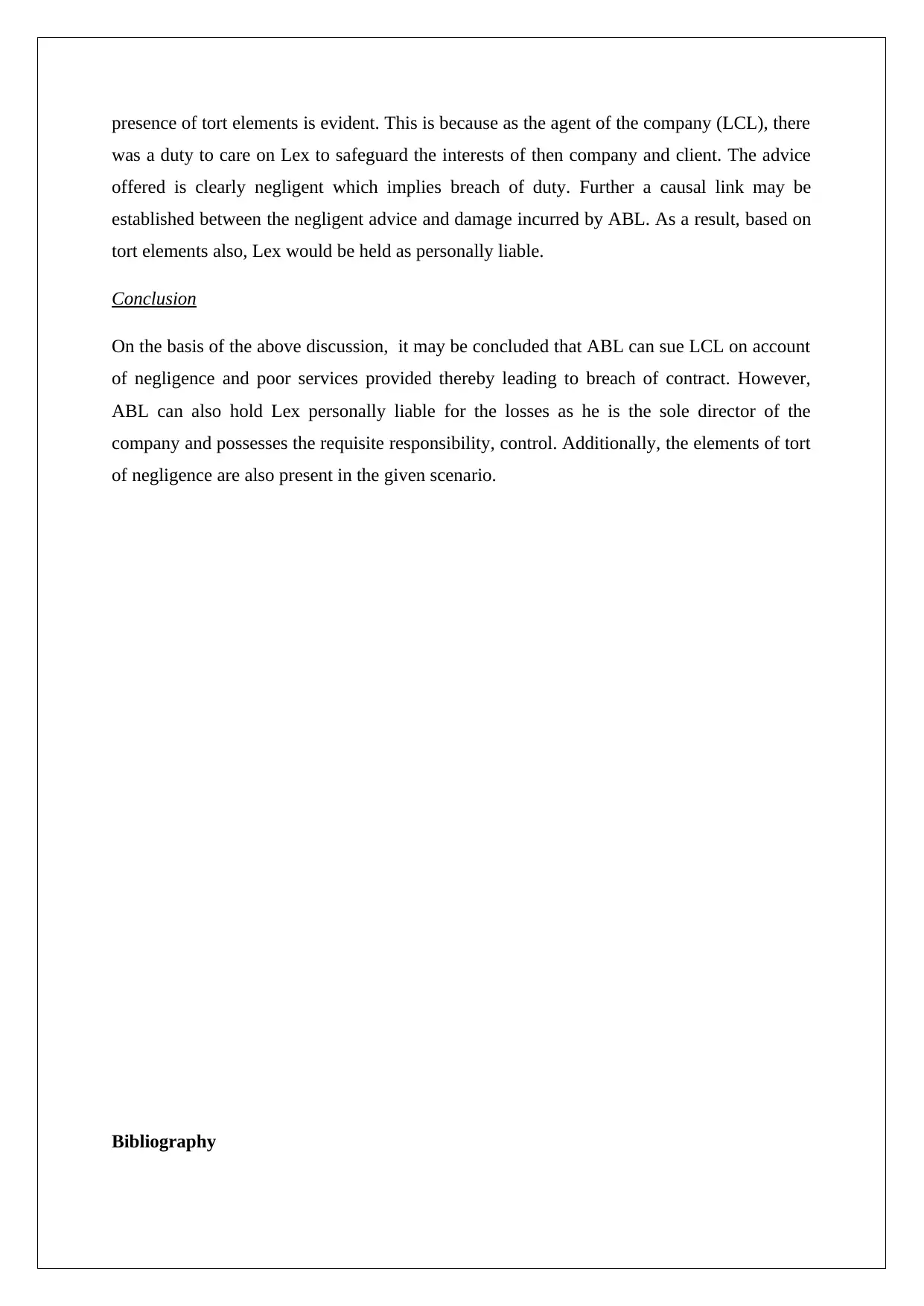
presence of tort elements is evident. This is because as the agent of the company (LCL), there
was a duty to care on Lex to safeguard the interests of then company and client. The advice
offered is clearly negligent which implies breach of duty. Further a causal link may be
established between the negligent advice and damage incurred by ABL. As a result, based on
tort elements also, Lex would be held as personally liable.
Conclusion
On the basis of the above discussion, it may be concluded that ABL can sue LCL on account
of negligence and poor services provided thereby leading to breach of contract. However,
ABL can also hold Lex personally liable for the losses as he is the sole director of the
company and possesses the requisite responsibility, control. Additionally, the elements of tort
of negligence are also present in the given scenario.
Bibliography
was a duty to care on Lex to safeguard the interests of then company and client. The advice
offered is clearly negligent which implies breach of duty. Further a causal link may be
established between the negligent advice and damage incurred by ABL. As a result, based on
tort elements also, Lex would be held as personally liable.
Conclusion
On the basis of the above discussion, it may be concluded that ABL can sue LCL on account
of negligence and poor services provided thereby leading to breach of contract. However,
ABL can also hold Lex personally liable for the losses as he is the sole director of the
company and possesses the requisite responsibility, control. Additionally, the elements of tort
of negligence are also present in the given scenario.
Bibliography
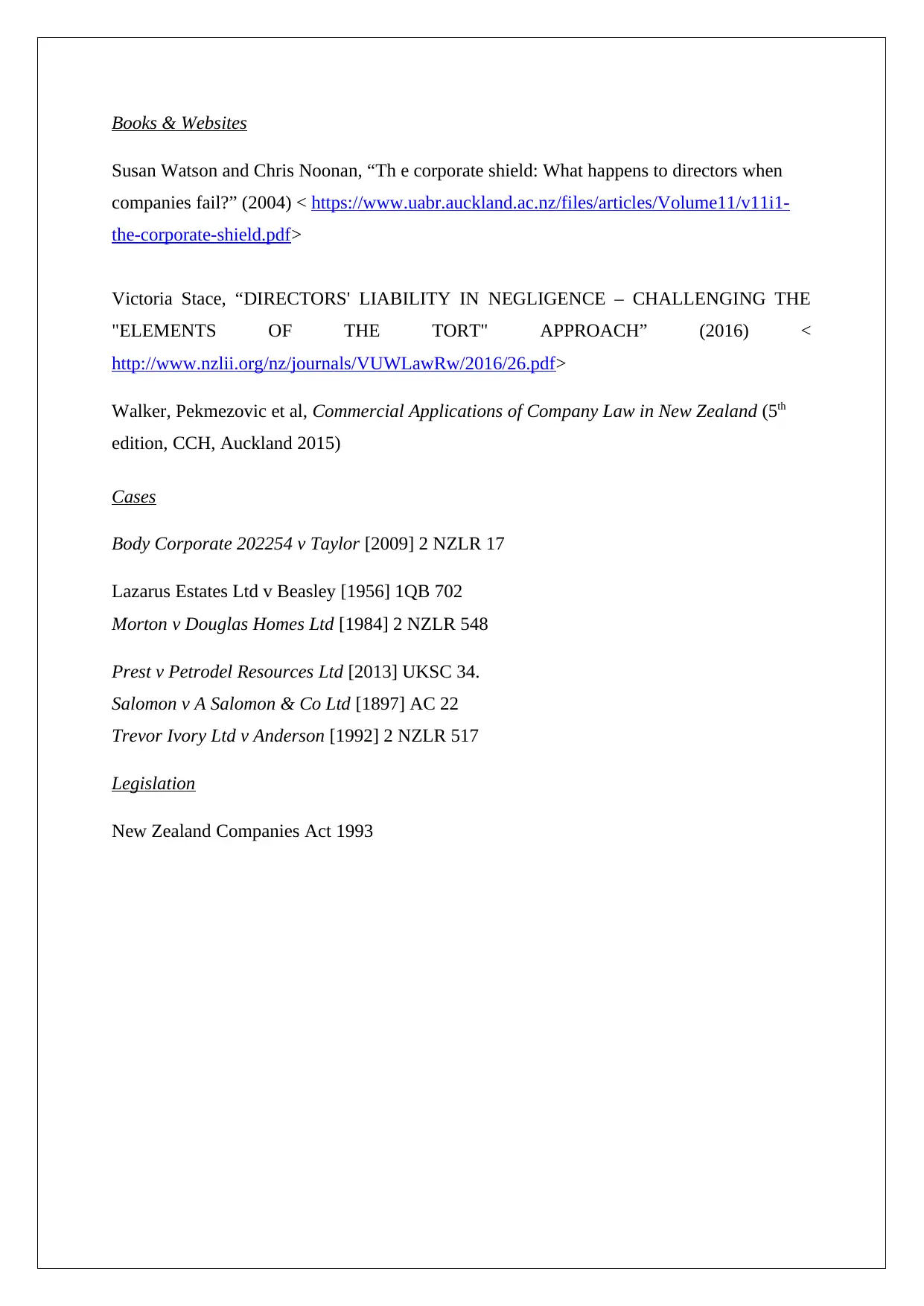
Books & Websites
Susan Watson and Chris Noonan, “Th e corporate shield: What happens to directors when
companies fail?” (2004) < https://www.uabr.auckland.ac.nz/files/articles/Volume11/v11i1-
the-corporate-shield.pdf>
Victoria Stace, “DIRECTORS' LIABILITY IN NEGLIGENCE – CHALLENGING THE
"ELEMENTS OF THE TORT" APPROACH” (2016) <
http://www.nzlii.org/nz/journals/VUWLawRw/2016/26.pdf>
Walker, Pekmezovic et al, Commercial Applications of Company Law in New Zealand (5th
edition, CCH, Auckland 2015)
Cases
Body Corporate 202254 v Taylor [2009] 2 NZLR 17
Lazarus Estates Ltd v Beasley [1956] 1QB 702
Morton v Douglas Homes Ltd [1984] 2 NZLR 548
Prest v Petrodel Resources Ltd [2013] UKSC 34.
Salomon v A Salomon & Co Ltd [1897] AC 22
Trevor Ivory Ltd v Anderson [1992] 2 NZLR 517
Legislation
New Zealand Companies Act 1993
Susan Watson and Chris Noonan, “Th e corporate shield: What happens to directors when
companies fail?” (2004) < https://www.uabr.auckland.ac.nz/files/articles/Volume11/v11i1-
the-corporate-shield.pdf>
Victoria Stace, “DIRECTORS' LIABILITY IN NEGLIGENCE – CHALLENGING THE
"ELEMENTS OF THE TORT" APPROACH” (2016) <
http://www.nzlii.org/nz/journals/VUWLawRw/2016/26.pdf>
Walker, Pekmezovic et al, Commercial Applications of Company Law in New Zealand (5th
edition, CCH, Auckland 2015)
Cases
Body Corporate 202254 v Taylor [2009] 2 NZLR 17
Lazarus Estates Ltd v Beasley [1956] 1QB 702
Morton v Douglas Homes Ltd [1984] 2 NZLR 548
Prest v Petrodel Resources Ltd [2013] UKSC 34.
Salomon v A Salomon & Co Ltd [1897] AC 22
Trevor Ivory Ltd v Anderson [1992] 2 NZLR 517
Legislation
New Zealand Companies Act 1993
1 out of 7
Related Documents
Your All-in-One AI-Powered Toolkit for Academic Success.
+13062052269
info@desklib.com
Available 24*7 on WhatsApp / Email
![[object Object]](/_next/static/media/star-bottom.7253800d.svg)
Unlock your academic potential
© 2024 | Zucol Services PVT LTD | All rights reserved.




